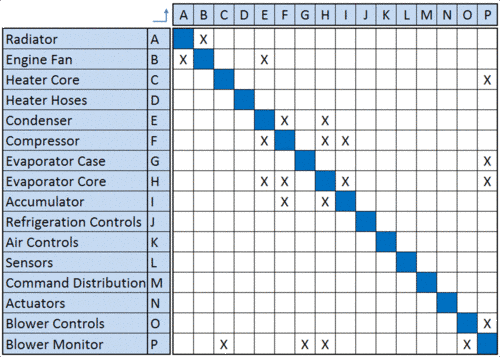Modularity and Black-Boxing
Abstract
This article is part from the course 42433 – Advanced Engineering Project, Program and Portfolio Management E15 at DTU. This is an individual assignment and the reason why this topic has been selected is because of the personal interest of the author on it. To allow success in a company, project or program it is important to learn how to transform complex systems (meaning processes, concepts, architectures, etc.), in small boxes that can be easily handled. The structure of this article is defined by the following sections:
- Modularity in different areas: Within the field of engineering modularity can be used in many different areas, this article will focus on three main areas of interest: product architecture, portfolio management and project management, and how they build each other.
- Techniques: Here it will be addressed how to take to due modularity and two techniques will be described (black-boxing and MFD)
- Limitations: This final section will discuss the limitations of this concept applied to the areas described in the article
Contents |
Introduction
Modularity refers to how components relate. It consist on coupling and decoupling, connect and disconnect the different parts and features of a product. The term modularity is used in a wide range of fields within management. It means that systems can be decomposed into subsystems that can be matched in many different configurations. Those subsystems are components, and they have the ability to interact, connect or exchange variety of resources. To make this possible it needs to be defined a standard interface. Imagine modules as puzzle pieces and the interface the puzzle panel. In Industrial design, modularity refers to an engineering technique that builds larger systems by combining smaller subsystems. In manufacturing, modularity refers to the use of exchangeable parts or options in the fabrication of an object
Modularity in different fields
Modularity in product architecture
Every product architecture is based in modularity. Modularity is the key for managing complexity and the more complexity there is in a product the more useful will be the use of modules or black-boxes. Product family architectures are crucial in the development of new products within a family. A good modularization allows a wide range of products within the same product family, which means customization and optimization. Optimization in means of reducing the cost of manufacturing and time to market. By improving processes and sharing a common language. Strategic modularization is based in a shared platform and the definition on the modules of the product. Those modules can be defined by function or assembly. This is a strategy since it allows a better approach to portfolio management within a company. If the modules are well defined and they share resources and physical interfaces it becomes much easier to make them relate to create a wide range of variety without increasing cost (processes and materials) and time to market. To decide the future architecture of a product it can be helpful to think on the module drives described by Erixon 1998. The modular function development (MFD) is a good approach for the identification of those modules having the starting point in the customer requirements and the module drivers. A way to decompose a product into standard designs, modules or platforms is the “Design Structured Matrix” which can be seen in the picture.
Modularity in portfolio management
The modularization is also applied in a superior level, at portfolio management. This modularization allows the creation of product families in a portfolio by simplifying processes and saving materials, which also means optimization in means of money, time to release the product and customization. A company’s portfolio is classified in families and subfamilies decoupling systems and processes. This aids the production and help to manage easier projects within a company.
Modularity in Project management
Regarding modularity of projects it allows the internal design strategy by shorting the time to learn and making the process more efficient that could be basis for a competitive advantage.
Techniques
Wrapping up, modularization is a strategic behavior that allows managing complex systems and process by decoupling them.
Blackboxing
The term black-box engineering is derived from the fact that the component in question appears as a black box, what means that to see the overall system it is not necessary to have it all. It consist in making groups of the process that are similar in time, shape or resources and put it in a black box and show how they relates. If it is necessary a black box can be open and you can look what there is inside, maybe many systems or more black boxes.
Modular Function deployment
Modular function deployment is a structured approach for modularization of products based on Erixon 1998 and module drivers. This approach consist of 5 tools linked together and the objective is to identify the different modules of a given product. Steps to follow: 1* Identification of the customers’ requirements described a QFD-matrix. 2* Identify functions and corresponding technical solutions. 3* Analyze technical solutions regarding their reasons for being modules. The output here is module candidates. 4* Analyze modules according to their interfaces, lead times, cost, etc. 5* Made specifications for each module.
References
Oehmen, J. et al 2015
Developing productc families based on architecture, Ulf Harlou

